Precor LOW-IMPACT TREADMILLS 9.33 User Manual
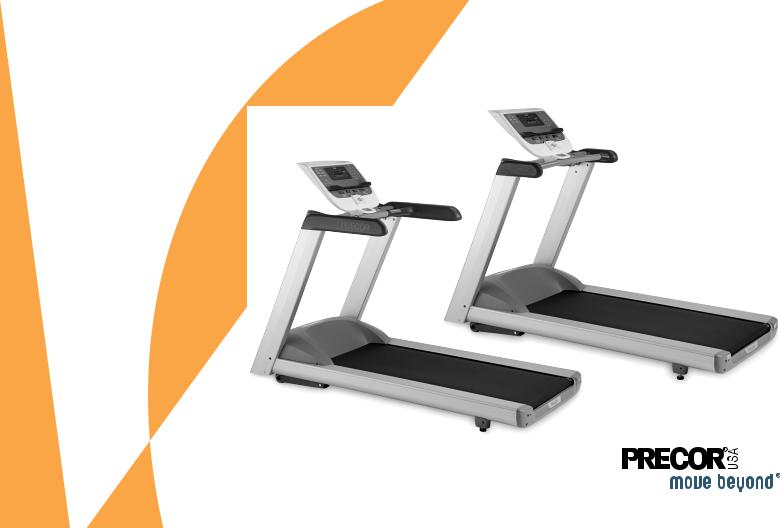
9.31
9.33

Important Safety Instructions
When using a treadmill, always take basic precautions, including the following:
•Read all instructions before using the treadmill. These instructions are written for your safety and to protect the unit.
•Before beginning any fitness program, see your physician for a complete physical examination.
Il est conseillé de subir un examen médical complet avant d’entreprendre tout programme d’exercise. Si vous avez des étourdissements ou des faiblesses, arrêtez les exercices immédiatement.
DANGER |
To reduce the risk of electrical shock |
|
always unplug the treadmill from the |
||
|
||
|
electrical outlet immediately after |
|
|
using and before cleaning. |
|
WARNING |
To reduce the risk of burns, fire, |
|
|
electric shock, or injury, take the |
|
|
following precautions: |
•Do not allow children or those unfamiliar with its operation on or near the treadmill. Do not leave children unsupervised around the unit.
•Never leave the treadmill unattended when it is plugged in. Unplug the treadmill from the power source when it is not in use, before cleaning it, and before acquiring authorized service.
•Assemble and operate the treadmill on a solid, level surface. Locate the treadmill a few feet from walls or furniture. Keep the area behind the treadmill clear.
•Maintain the treadmill in good working condition. Refer to the Maintenance section. Make sure that all fasteners are secure and the running belt is clean and running smoothly.
•Use the treadmill only for its intended purpose as described in this manual. Do not use accessory attachments that are not recommended by the manufacturer, as such attachments may cause injuries.
•Never operate the unit if it is damaged, not working properly, when it has been dropped, or has been dropped in water. Return the treadmill to a service center for examination and repair.
•Keep the power cord and plug away from heated surfaces.
•Do not operate the treadmill where aerosol (spray) products are being used or where oxygen is being administered.
NSTRUCTIONSI AFETYS MPORTANTI
Owner’s Manual: Important Safety Instructions |
1 |

•Do not use outdoors.
•Do not attempt to service the treadmill yourself except to follow the maintenance instructions found in this manual.
•Never drop or insert objects into any opening. Keep hands away from moving parts.
•Keep all electrical components, such as the power cord and power switch, away from liquids to prevent shock.
•Do not set anything on the handrails, display console, or hood. Place liquids, magazines, and books in the appropriate receptacles.
•Do not rock the unit. Do not stand on the handrail(s), display console, or hood.
DANGER |
The treadmill must be connected to a |
|
dedicated, grounded circuit. See |
|
Grounding Instructions. |
•Wear proper exercise clothing and shoes for your workout and avoid loose clothing. Do not wear shoes with heels or leather soles. Check the soles of your shoes and remove any dirt and embedded stones. Tie long hair back.
•Use care when getting on or off the treadmill. Always grasp the handrail when stepping on the running belt and keep the initial speed at or below 1 mile per hour (mph) or 1 kilometer per hour (kph). Never step off the treadmill while the running belt is moving.
•Before the running belt begins moving (before your workout), and after it stops (at the end of your workout), straddle the belt by placing your feet firmly on the right and left staging platforms.
•Keep your body and head facing forward. Never attempt to turn around on the treadmill.
•The safety clip must be attached at waist level before your workout. A lanyard connects to the magnetic safety key near the red STOP button. If you encounter difficulties, a strong tug on the lanyard disengages the magnetic safety key and stops the running belt.
•Do not overexert yourself or work to exhaustion. If you feel any pain or abnormal symptoms, stop your workout immediately and consult your physician.
•When the treadmill is not in use, disconnect the unit by turning the power switch to the Off position, and then remove the power plug from the power outlet.
NSTRUCTIONSI AFETYS MPORTANTI
Owner’s Manual: Important Safety Instructions |
2 |

Safety Code
To help prevent unauthorized use, the treadmill is equipped with a safety code. The safety code involves entering four keys in sequence. If the correct keys are not pressed within two minutes, further access is denied and the running belt will not move. For more information, refer to Entering the Safety Code.
Safety Approval
When identified with the ETL-c logo, the unit has been tested and conforms to the requirements of
CAN/CSA-E-335-1/3-04, EN 60335-1: 2002 Safety of Household and Similar Electrical Appliances.
Grounding Instructions
The treadmill must be grounded. If the unit malfunctions or breaks down, grounding provides a path of least resistance for electric current, which reduces the risk of electrical shock. The unit is equipped with a power cord having an equipment-grounding conductor and a grounding plug. The plug must be inserted into an outlet that is properly installed and grounded in accordance with all local codes and ordinances. Failure to properly ground the treadmill could void the Precor Limited Warranty.
DANGER |
Improper connection of the |
|
equipment-grounding conductor can |
|
result in a risk of electric shock. Check |
|
with a qualified electrician or service |
|
person if you are in doubt as to |
|
whether the unit is properly |
|
grounded. Do not modify the plug |
|
provided with the treadmill. If it does |
|
not fit the outlet, get a proper outlet |
|
installed by a qualified electrician. |
NSTRUCTIONSI AFETYS MPORTANTI
Owner’s Manual: Important Safety Instructions |
3 |

120 V and 240 V Units Designated for U.S. Markets
The treadmill must be connected to a dedicated, grounded circuit. A 15 amp dedicated circuit is required, but a
20 amp dedicated circuit is recommended. The power outlet must have the same configuration as the plug. No adapter should be used with this product.
240 V Units Designated for International Markets
Your dealer must supply and verify that the treadmill is equipped with an IEC approved 60320 C19 Inlet connector, which has an IEC approved, SJT 60° minimum, international color-code, 3 x 1.5mm 2 power cord. The power cord must be equipped with a local connector that can be plugged into an electrical outlet on a dedicated circuit. No adapter should be used with this product.
Radio Frequency Interference (RFI)
Federal Communications Commission, Part 15
The treadmill has been tested and found to comply with
•the limits for a Class B digital device, pursuant to Part 15 of the FCC Rules. These limits are designed to provide reasonable protection against harmful interference in a residential installation. The treadmill generates, uses, and can radiate radio frequency energy and, if not installed and used in accordance with the owner’s manual instructions, may cause harmful interference to radio communications.
If the treadmill does cause harmful interference to radio or television reception, which can be determined by turning the unit Off and On, you are encouraged to try to correct the interference using one or more of the following measures:
•Reorient or relocate the receiving antenna for your TV, radio, VCR, etc.
•Increase separation between the unit and the receiver (TV, radio, etc.).
NSTRUCTIONSI AFETYS MPORTANTI
Owner’s Manual: Important Safety Instructions |
4 |

•Connect the treadmill into a different power outlet on a dedicated circuit different from the one used by the receiver (TV, radio, etc.). No other appliance should be plugged into the same power outlet as the treadmill.
•Consult an experienced radio/TV technician for help.
WARNING |
Per FCC rules, changes or |
|
modifications not expressly |
|
approved by Precor could void the |
|
user’s authority to operate the |
|
equipment. |
Canadian Department of Communications
This digital apparatus does not exceed the Class B limits for radio noise emissions from digital apparatus set out in the Radio Interference Regulations of the Canadian Department of Communications.
Le présent appareil numérique n’émet pas de bruits radioéélectriques dépassant les limites applicables aux appareils numériques de la class B prescrites dans le Règlement sur le brouillage radioélectrique édicté par le ministére des Communications du Canada.
ATTENTION: Haute Tension
Débranchez avant de réparer
European Applications
This product is compliant to:
•2004/108/EC Electromagnetic Compatibility Directive.
•2006/95/EC Low Voltage Directive.
•2002/95/EC Restriction of Hazardous Substances Directive.
This product conforms to the requirements of the European Council Directive 89/336/EEC, 2004/108/EC Electromagnetic Compatibility and has been tested to the following standards:
•EN55022, Limits & Methods of Measurement of Radio Interference, Information Technology Equipment.
•EN55024, Immunity of Information Technology Equipment.
This product also conforms to the requirements of the European Council Directive 73/23/EEC, 2006/95/EC Low Voltage Directive and has been tested to the following standard:
•IEC 335-1, EN60335-1 Safety of Household and similar Electrical Appliances.
NSTRUCTIONSI AFETYS MPORTANTI
Owner’s Manual: Important Safety Instructions |
5 |
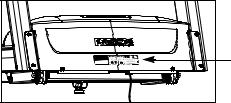
Product Recycling and Disposal
This equipment must be recycled or discarded according to applicable local and national regulations.
Product labels, in accordance with European Directive 2002/96/ EC concerning waste electrical and electronic equipment (WEEE), determine the framework for the return and recycling of used equipment as applicable throughout the European Union. The WEEE label indicates that the product is not to be thrown away, but rather reclaimed upon end of life per this Directive.
In accordance with the European WEEE Directive, electrical and electronic equipment (EEE) is to be collected separately and to be reused, recycled, or recovered at end of life. Users of EEE with the WEEE label per Annex IV of the WEEE Directive must not dispose of end of life EEE as unsorted municipal waste, but use the collection framework available to customers for the return, recycling, and recovery of WEEE. Customer participation is important to minimize any potential effects of EEE on the environment and human health due to the potential presence of hazardous substances in EEE. For proper collection and treatment, refer to Obtaining Service.
Obtaining Service
You should not attempt to service the treadmill except for maintenance tasks as described in this manual. The treadmill does not contain any user-serviceable parts that require lubrication. For information about product operation or service, see the Precor web site at www.precor.com.
Should you need more information regarding customer support numbers or a list of Precor authorized service centers, visit the Precor web site at www.precor.com.
For future reference, write the model, serial number, and date of purchase for your unit in the space provided. The serial number is printed on a label located on the front panel, near the power cord (Diagram 1).
Model #: _______ |
Serial #: _______________________ |
Date purchased: _________________________
Serial number label
Diagram 1: Location of serial number
Owner’s Manual: Important Safety Instructions |
6 |

Table of Contents
Important Safety Instructions ............................. |
1 |
Safety Code ........................................................................... |
3 |
Safety Approval ..................................................................... |
3 |
Grounding Instructions ........................................................ |
3 |
Radio Frequency Interference (RFI) ................................. |
4 |
European Applications ........................................................ |
5 |
Product Recycling and Disposal ....................................... |
6 |
Obtaining Service ................................................................. |
6 |
Treadmill Safety Features .............................................. |
9 |
Using the Safety Clip ........................................................... |
9 |
Entering the Safety Code ................................................ |
10 |
Using the Handrails ........................................................... |
10 |
Turning the Unit On and Off ............................................ |
10 |
Location ............................................................................... |
10 |
Heart Rate Features ...................................................... |
11 |
Important Use and Safety Information .......................... |
11 |
Using the Touch-Sensitive Grips ................................... |
14 |
Using SmartRate ................................................................ |
14 |
Exercise to Your Target Heart Rate ............................... |
16 |
Heart Rate Analysis ........................................................... |
16 |
Display Console .............................................................. |
17 |
More Information about the Heart Rate and |
|
Center Displays .................................................................. |
19 |
More Information about the Lower Display .................. |
19 |
Keypads ............................................................................... |
21 |
User Identification .......................................................... |
27 |
Adding a User ..................................................................... |
28 |
Updating User Information ............................................... |
29 |
Changing the User Name and Clearing |
|
Workout Statistics ............................................................. |
30 |
Workout Options ............................................................ |
31 |
Choosing QUICKSTART ................................................. |
32 |
Selecting a Program .......................................................... |
33 |
Selecting a USER Key ...................................................... |
34 |
Recording Your Personal Best Time ............................. |
35 |
Changing Programs in Mid-session ............................... |
35 |
Cooling Down After a Workout ...................................... |
36 |
Pausing During a Workout or the |
|
Cool-Down Period ............................................................. |
37 |
Ending a Workout .............................................................. |
38 |
Owner’s Manual: Table of Contents |
7 |
Programs .......................................................................... |
39 |
Choosing a Program ......................................................... |
39 |
Program Tips ...................................................................... |
39 |
Manual Program ................................................................. |
40 |
Interval Program ................................................................. |
41 |
Random Program ............................................................... |
41 |
Custom Programs .............................................................. |
42 |
Heart Rate Programs ........................................................ |
43 |
Heart Rate Program Tips ................................................. |
44 |
Weight Loss Programs ..................................................... |
45 |
5K Program ......................................................................... |
46 |
10K Program ...................................................................... |
46 |
Mile Program ....................................................................... |
47 |
WALK Programs ................................................................ |
47 |
RUN Programs ................................................................... |
48 |
Advanced Programming and Troubleshooting ..... |
49 |
Advanced Programming Tips .......................................... |
49 |
Changing Treadmill Settings ........................................... |
50 |
Informational Displays ....................................................... |
53 |
Troubleshooting Error Codes ......................................... |
57 |
Troubleshooting Heart Rate ............................................ |
57 |
Maintenance .................................................................... |
58 |
Inspection ............................................................................ |
58 |
Cleaning the Equipment ................................................... |
58 |
Storing the Chest Strap ................................................... |
59 |
Checking the Alignment of the Running Belt .............. |
59 |
Adjusting the Running Belt .............................................. |
60 |
Long-Term Storage ............................................................ |
61 |
Precor Residential Equipment |
|
Limited Warranty.................................................. |
62 |
Owner’s Manual: Table of Contents |
8 |
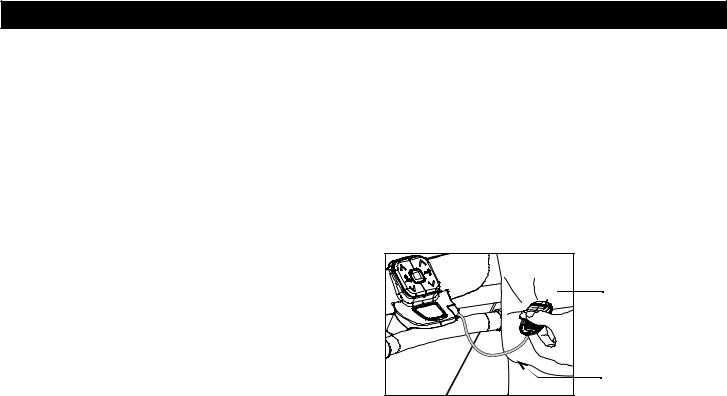
Treadmill Safety Features
The treadmill is equipped with certain items that, when used properly, help sustain an enjoyable workout. These items include:
•Safety clip and magnetic safety key
•Safety code
•Handrails
•Power switch
Important: Before exercising, review the Important Safety Instructions found at the beginning of this manual.
Using the Safety Clip
Attach the safety clip to your clothing before each workout. Refer to Diagram 4. A tug on the lanyard disengages the magnetic safety key and trips the safety switch inside the display console which stops the running belt.
If the safety switch trips while you are exercising, the running belt stops and the treadmill enters pause mode. A ten-minute countdown appears in the upper display.
Note: If the safety switch trips while the banner is scrolling across the display, STOP KEY appears.
To resume exercising, take the following steps:
1.If needed, reattach the safety clip to your clothing and the magnetic safety key onto the display console.
2.Straddle the running belt.
3.Press QUICKSTART or the SPEED up arrow key.
4.If needed, enter the safety code.
5.Hold onto a handrail while you step on to the running belt with the speed at or below 1 mph or 1 kph.
Note: The treadmill retains your workout statistics if you resume exercising within 10 minutes.
Safety clip |
Lanyard |
Diagram 4: Attach the safety clip to your clothing
Owner’s Manual: Treadmill Safety Features |
9 |
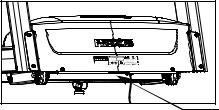
Entering the Safety Code
The treadmill provides a safety code to help prevent unauthorized use. When you initially assemble the treadmill, the safety code is disabled. To enable it, refer to the instructions found in Changing Treadmill Settings.
If you are prompted for a safety code, press the following number sequence: 1, 2, 3, 4.
Turning the Unit On and Off
To turn the unit On and Off, use the power switch located at the front of the unit, near the power cord connection. Refer to Diagram 5.
Important: When it is not being used, turn the unit Off.
An asterisk appears on the display with each key press. If a key is not pressed within 30 seconds or the correct safety code is not entered within two minutes, the banner appears on the display and the running belt does not move.
Important: Do not assume the treadmill is safe because of
safety code protection. Never leave children unsupervised |
Power switch |
|
|
around the treadmill. Always turn Off and unplug the |
Diagram 5: Power switch |
treadmill when it is not in use. |
|
Using the Handrails
To maintain your balance, always grasp a handrail extension when you step on or off the treadmill, and when you use the keypad.
To learn more about the touch-sensitive grips on the 9.33, refer to Heart Rate Features.
Location
It is important to keep the area around the treadmill open and free from encumbrances such as other equipment. The minimum space requirement needed for user safety and proper maintenance is three feet wide by six feet deep
(one meter wide by two meters deep), directly behind the running belt.
Owner’s Manual: Treadmill Safety Features |
10 |

Heart Rate Features
Important Use and Safety Information
Read the following before using the heart rate or SmartRate features.
SmartRate
Heart rate and SmartRate® features are available when
you wear the chest strap or grasp both touch-sensitive grips (9.33 only). When a heartbeat is detected, the HEART RATE display shows your heart rate and, if your age has been entered, the SmartRate LED pulses and indicates your target zone.
•Consult your physician before engaging in any vigorous exercise. Do not use the heart rate programs until authorized by your physician.
•Know your heart rate and your physician-recommended heart rate target zone. Individual heart rates vary according to several physiological factors and may not correspond directly with Diagram 6.
Owner’s Manual: Heart Rate Features |
11 |

•The calculation used for the heart rate target zone is: (220 minus your age) multiplied by a percent.
For example:
Low range: (220 minus your age) multiplied by 55% High range: (220 minus your age) multiplied by 85% Refer to Table 1 in Using SmartRate.
Heart Rate Target Zones
Your Heart Rate
200
190
180
170
160
150
140
130
120
110
100
90
80
70
20 25
Recom mended C ardiovascular Z one Recommended W eight Loss Zo ne
30 35 40 45 50 55 60 65 70 75
Your Age
High
Peak
Cardio
Fat Burn
Warmup
Diagram 6: Heart rate target zones
•After you put on the chest strap, face the display console for a few seconds. This allows the receiver in the console to recognize the signal from the chest strap.
•If Hr appears on the display, the treadmill is detecting a signal, but has not yet determined your heart rate. Make sure the chest strap is positioned properly around your chest and against your skin.
•If you prefer to use the touch-sensitive grips on the 9.33, grasp both touch-sensitive grips and wait five to ten seconds. Make sure both hands are moist.
Note: When a signal is detected, a number flashes in the HEART RATE display and indicates your heart rate.
•Always face forward on the treadmill and use the handrail for balance. Keep upper body movement to a minimum.
Owner’s Manual: Heart Rate Features |
12 |
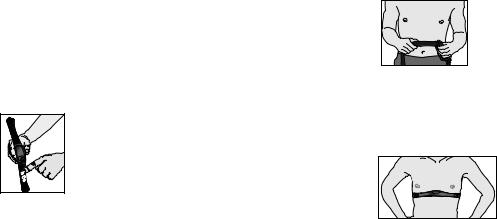
Wearing a Chest Strap
During a workout, the heart rate features appear on the display when you wear a chest strap. To receive an accurate reading, the chest strap needs to be in direct contact with your skin.
1.Carefully dampen the back of the strap with tap water Refer to Diagram 7.
Note: Do not use deionized water. It does not have the proper minerals and salts to conduct electrical impulses.
Diagram 7: Moisten chest strap
2.Adjust the strap and fasten it around your chest. The strap should feel snug, not restrictive. Refer to Diagram 8.
.
Diagram 8: Adjust chest strap
3.Make sure that the chest strap is right side up, lies horizontally across your chest, and is centered in the middle of your chest. Refer to Diagram 9.
Diagram 9: Fasten chest strap
After you put on the chest strap, face the display console for a minimum of 15 seconds. This allows the receiver in the console to recognize the signal from the chest strap.
Owner’s Manual: Heart Rate Features |
13 |
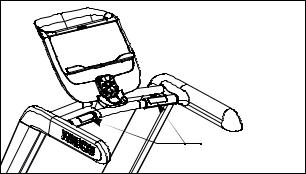
Using the Touch-Sensitive Grips
While exercising, you must grasp both touch-sensitive grips for a minimum of five to ten seconds to transmit your heart rate to the display. Refer to Diagram 10.
Touch-sensitive grips (9.33 only)
Diagram 10: Touch-sensitive grips on the 9.33
Usually, the concentration of salts in a person’s perspiration provides enough conductivity to transmit a signal to the receiver inside the display console. However, some people, because of body chemistry or erratic heart beats cannot use the touch-sensitive heart rate feature on the treadmill. A chest strap may provide better results.
Important: While exercising, do not grasp the touchsensitive grips and wear the chest strap at the same time. The touch-sensitive grips override the signals from the chest strap transmitter. If used together, inconsistent readings may occur.
Using SmartRate
The SmartRate feature helps you monitor and maintain your heart rate in the target zone best suited to your specific needs. All 7 green LEDs may light during a workout. When the treadmill detects a heart rate, a single LED blinks and indicates the zone that your heart rate is in.
Important: To use the SmartRate feature, you must choose a program and enter your age during the setup phase of your exercise session.
Table 1 shows the percents used in calculating the heart rate target zones. While your heart rate remains within these zones, the corresponding lights blink and provide a visual cue.
Owner’s Manual: Heart Rate Features |
14 |

The calculation used to determine your maximum aerobic heart rate is (220 minus your age). When you multiply it by the percent indicated in Table 1, you can understand the relation-ship between the pulsating LED and your target heart rate.
CAUTION: Your heart rate should never exceed 85% of your maximum aerobic heart rate or go above PEAK. If it does, immediately reduce your pace or adjust the incline to return your heart rate to your physician-recommended target zone.
Table 1. Heart rate target zones and SmartRate LEDs
Heart Rate Zone |
|
|
Percent |
LED Blinking |
Label |
|
|
|
Below 55 |
First |
WARMUP |
|
|
|
55 to 61 |
Second |
FATBURN |
|
|
|
62 to 69 |
Third |
FATBURN |
70 to 77 |
Fourth |
CARDIO |
78 to 84 |
Fifth |
CARDIO |
85 to 87 |
Sixth |
PEAK |
|
|
|
Above 87 |
Seventh |
HIGH |
|
|
|
The SmartRate indicator lights do not appear when:
•You press QUICKSTART at the banner.
•You do not enter your age before starting a program.
•You do not wear or improperly position the chest strap.
•You fail to grasp both touch-sensitive grips on the 9.33 for five to ten seconds.
Owner’s Manual: Heart Rate Features |
15 |
Exercise to Your Target Heart Rate
A heart rate receiver is an integral part of the display so you can monitor your heart rate while exercising. You must wear a chest strap if you are using the 9.31 treadmill. If you own a 9.33 treadmill, you have the option of wearing a chest strap or grasping both touch-sensitive grips. Your heart rate (beats per minute) appears on the display.
The Precor web site (www.precor.com) has several suggestions for workouts with varying levels of intensity. It provides many workout details that include the appropriate target heart rate.
The 9.31 treadmill includes one program that lets you exercise based on a specified target heart rate. The 9.33 treadmill contains two: Basic HR and Weight Loss HR. As you exercise, the heart rate programs monitor your heart rate and automatically maintain it within a target heart rate zone.
To use these programs, press the PROGRAMS - HEART RATE key. Refer to Table 2. For more information, refer to
Programs.
Table 2. Heart rate programs
PROGRAMS - HEART RATE |
9.31 |
9.33 |
|
|
|
Basic HR |
|
|
|
|
|
Weight Loss HR |
|
|
|
|
|
Heart Rate Analysis
Every time you complete a program using the chest strap or 9.33 touch-sensitive grips, the treadmill provides a heart rate analysis after the workout summary.
Your average heart rate appears followed by the maximum heart rate achieved during your workout. A third display appears, if you entered your age, and indicates the amount of time your heart rate remained between the target zones shown.
The heart rate analysis is based on how often your heart rate signal is received while exercising. If you use the chest strap, the average heart rate will be more accurate than if you occasionally grasp the touch-sensitive grips on the 9.33 treadmill.
Owner’s Manual: Heart Rate Features |
16 |
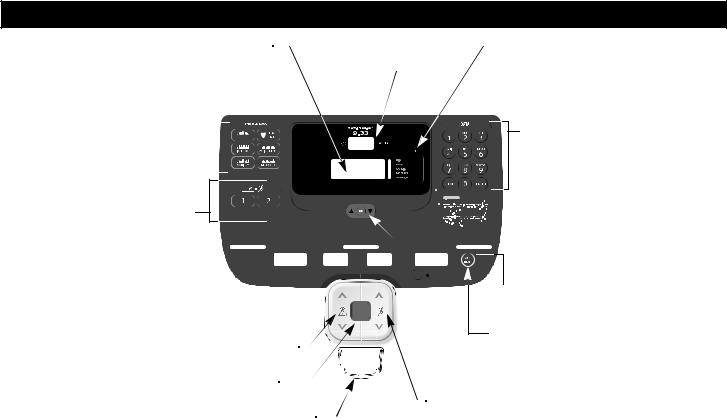
Display Console
Center display: Initially shows the banner. It changes  to the program profile when you select a program or press QUICKSTART. A blinking column in the profile indicates your position.
to the program profile when you select a program or press QUICKSTART. A blinking column in the profile indicates your position.
PROGRAMS keypad: To begin an |
|
|
|
|
|
|
|
||
exercise session, press a PROGRAMS |
|
|
|
MANUAL |
|
|
|
||
key to view a menu of programs within |
|
|
|
|
each category. For program |
|
|
|
|
descriptions, refer to Programs. |
|
|
|
|
|
|
|
||
HEART RATE display: The HEART RATE display your pulse. 
SmartRate
 SmartRate display: LEDs light in this column when the SmartRate feature is activated. Follow the LEDs to monitor your heart rate and maintain it in your target zone.
SmartRate display: LEDs light in this column when the SmartRate feature is activated. Follow the LEDs to monitor your heart rate and maintain it in your target zone.
Number keys: During an exercise session, use the number keys to answer prompts and update information.
User 1—2: Two USER keys are available on the 9.33 treadmill. Press a
USER key at the banner to personalize your exercise experience. The
information is stored for future exercise sessions.
Selection key: Press the key to move 
 through the information in the column, so
through the information in the column, so
you can choose what you want to display during your session. Indicator lights appear next to the item that is displayed.
 TIME ELAPSED
TIME ELAPSED  TIME REMAINING
TIME REMAINING  CALORIES
CALORIES
INCLINE arrow keys: Use the  arrow keys to adjust the incline.
arrow keys to adjust the incline.
QUICKSTART: Press QUICKSTART to  begin your workout immediately.
begin your workout immediately.
INCLINE |
SPEED |
QUICK
START
Red STOP button: Press to pause or end a workout  and stop the running belt.
and stop the running belt.












 OK and Navigational arrow keys: Use the
OK and Navigational arrow keys: Use the 











 OK key to confirm responses to specific
OK key to confirm responses to specific 










 prompts. The up and down arrow keys
prompts. The up and down arrow keys  present the available selection and affect
present the available selection and affect
Copyright 2006 Precor Incorporated en
what appears on the display.
 DISTANCE
DISTANCE
PACE
 AVERAGE SPEED
AVERAGE SPEED 
 Lower display: While you exercise, four sets of numbers show information about your session.
Lower display: While you exercise, four sets of numbers show information about your session.
PAUSE/RESET key: Press it once to enter pause mode. Press it again to display a workout summary. Press it once more to end your exercise session.
 SPEED arrow keys: Use the arrow keys to adjust the speed.
SPEED arrow keys: Use the arrow keys to adjust the speed.
Owner’s Manual: Display Console |
17 |

Center display: Initially shows the banner. It changes  to the program profile when you select a program or press QUICKSTART. A blinking column in the profile indicates your position.
to the program profile when you select a program or press QUICKSTART. A blinking column in the profile indicates your position.
HEART RATE display: The HEART RATE display your pulse. 
 SmartRate display: LEDs light in this column when the SmartRate feature is activated. Follow the LEDs to monitor your heart rate and maintain it in your target zone.
SmartRate display: LEDs light in this column when the SmartRate feature is activated. Follow the LEDs to monitor your heart rate and maintain it in your target zone.
PROGRAMS keypad: To begin an
MANUAL
exercise session, press a PROGRAMS key to view a menu of programs within
each category. For program descriptions, refer to Programs.
Selection key: Press the key to move
through the information in the column, so you can choose what you want to
display during your session. Indicator lights appear next to the item that is
displayed.
 TIME ELAPSED
TIME ELAPSED
TIME REMAINING
 CALORIES
CALORIES
QUICK
START
INCLINE arrow keys: Use the  arrow keys to adjust the incline.
arrow keys to adjust the incline.
QUICKSTART: Press QUICKSTART to  begin your workout immediately.
begin your workout immediately.
Red STOP button: Press to pause or end a workout  and stop the running belt.
and stop the running belt.
|
|
|
|
|
|
|
|
Number keys: During an exercise |
|
|
|
|
|
|
|
|
|
|
|
|
|
|
|
|
|
session, use the number keys to answer |
SmartRate |
|
|
prompts and update information. |
|||||
|
|
|
|
|
|
|
OK and Navigational arrow keys: Use the |
|
|
|
|
|
|
|
|
||
|
|
|
|
|
|
|
OK key to confirm responses to specific |
|
|
|
|
|
|
|
|
prompts. The up and down arrow keys |
|
|
|
|
|
|
present the available selection and affect |
|||
Copyright 2006 Precor Incorporated en |
|
|||||||
|
|
|
|
|
|
|
what appears on the display. |
|
 DISTANCE
DISTANCE
PACE
 AVERAGE SPEED
AVERAGE SPEED 
 Lower display: While you exercise, four sets of numbers show information about your session.
Lower display: While you exercise, four sets of numbers show information about your session.
PAUSE/RESET key: Press it once to enter pause mode. Press it again to display a workout summary. Press it once more to end your exercise session.
 SPEED arrow keys: Use the arrow keys to adjust the speed.
SPEED arrow keys: Use the arrow keys to adjust the speed.
Owner’s Manual: Display Console |
18 |
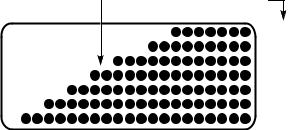
More Information about the Heart Rate and Center Displays
Your heart rate appears in the HEART RATE display if you are using a chest strap or the 9.33 touch-sensitive grips. Refer to Heart Rate Features.
In most programs, the incline setting affects the column height in the program profile as shown in Diagram 11. The profile raises or lowers according to which arrow key is pressed.
Column height |
|
Incline settings |
|
12 — 15
9 — 11.5
6 — 8.5
3 — 5.5
2 — 2.5
1 — 1.5
0.0 — 0.5
Diagram 11: Column height in the program profile
The center display presents the program name when you select a program. During an exercise session, the center display becomes a message bar showing additional information depending on user selections and program interludes.
More Information about the
Lower Display
The lower display consists of four windows which provide information about your exercise session. The two center windows automatically provide information about your incline and speed. To choose the type of information displayed in the left and right windows, press the adjacent Selection key. The numbers that appear relate to your workout statistics and are described below.
Note: If you choose to rest a book or magazine on the display, you can still view these workout statistics.
Owner’s Manual: Display Console |
19 |
Column 1: TIME ELAPSED and TIME
REMAINING
TIME ELAPSED—displays workout time in minutes and seconds and indicates the amount of time you have been exercising. When you exceed 60 minutes during a single workout, the TIME ELAPSED display converts to hours and minutes.
TIME REMAINING—shows the amount of time remaining in a workout. If the selected workout time is less than 60 minutes, the display shows time in minutes and seconds. If you select a workout time greater than 60 minutes, the display reflects hours and minutes until the countdown reaches 60 minutes, at which time the display reverts to minutes and seconds.
CALORIES—shows the cumulative number of calories being burned.
Column 2: INCLINE
INCLINE—displays the percentage of incline or decline during your workout. The INCLINE arrow keys affect the lift and let you set an incline between 0% and 15%. The values displayed can change in 0.5% increments.
Column 3: SPEED
SPEED—displays the running belt speed in miles per hour (mph) or kilometers per hour (kph). The running belt speed ranges from 0.5 and 12 mph (0.8 to 20 kph) and can be changed in 0.1 increments using the SPEED arrow keys.
Column 4: DISTANCE, PACE and AVERAGE
SPEED
DISTANCE—shows linear distance in either miles or kilometers. The distance is calculated based on your speed.
PACE—displays your target speed in minutes and seconds per mile (or kilometer). For example, the number 4:23 indicates that the pace (speed at which you are moving) is 4 minutes and 23 seconds per mile. When you press the SPEED arrow keys, the pace display changes accordingly (0.1 mile per key press). To designate a specific pace, use the PACE key. Refer to Navigational Keypad.
Note: If you are taking longer than an hour to complete a mile, the display shows hours and minutes.
AVERAGE SPEED—indicates the average speed associated with your workout.
Owner’s Manual: Display Console |
20 |
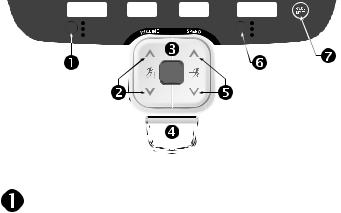
Keypads
Use the keypads to enter your workout session selections, to affect what appears on the display, and to establish your incline and speed preferences.
Five distinct keypads exist on the display and are discussed in this section:
•Lower Display keypad and the Selection keys
•User identification keys
•Navigational keypad in the center of the display
•PROGRAMS keypad
•Data keypad
Lower Display Keypad and the Selection Keys
TIME ELAPSED |
DISTANCE |
TIME REMAINING |
PACE |
CALORIES |
AVERAGE SPEED |
QUICK
START
Diagram 12: Lower Display keypad and the Selection keys
Left Selection Key: Every time you press this key the the display reflects the amount of time elapsed since you began your exercise session, or the time remaining, or the cumulative number of calories burned. An LED lights and indications which information is being displayed. The TIME REMAINING display is lit when you begin a program.
Owner’s Manual: Display Console |
21 |

INCLINE: Press and hold the INCLINE arrow keys to increase or decrease the incline from 0% to 15% in 0.5% increments.
Changes to the incline are not immediate. It takes time for the lift to reach the target incline shown on the display.
To change the incline in larger increments, use the number keys. Refer to Data Keypad.
The incline setting affects the column height in the program profile. The incline display shows the new setting.
QUICKSTART: Press QUICKSTART to start your workout immediately using the Manual Program. Refer to Choosing QUICKSTART.
STOP: A firm tap on the red STOP button slows the running belt to a stop and the treadmill enters pause mode. To resume, press QUICKSTART or the SPEED up arrow key and enter the safety code, if necessary. Refer to Pausing During a Workout or the Cool-Down Period.
SPEED: Press and hold the SPEED arrow keys to increase or decrease the running belt speed in 0.1 increments from 0.5 to 12 mph (0.8 to 20 kph).
To change the speed in larger increments, use the number keys. Refer to Data Keypad.
When you press the arrow keys, a target speed appears in the display. The running belt speed changes to meet the target, but the change occurs gradually so the transition is smooth.
PAUSE/RESET: This key has several functions during an exercise session. You press it once to enter pause mode. You press it again to display a workout summary. And, you press it a third time, to end your session and return to the banner. Refer to Pausing During a Workout or the Cool-Down Period.
Right Selection Key: Every time you press this key the display reflects either the distance travelled since you began your exercise session, your current pace, or your average speed. An LED lights and indicates which information is being displayed.
Owner’s Manual: Display Console |
22 |
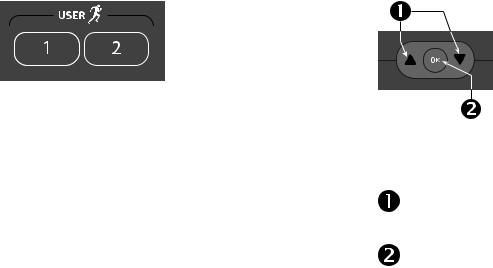
USER Keys |
Navigational Keypad |
Diagram 13: USER keys
User Keys: On the 9.33, you can personalize your exercise session by pressing a USER key (1 or 2) at the banner. Selecting a USER key lets you track your workout statistics from session to session. When you choose a USER key, personal information such as age, weight, and preferred program are reinstated as your exercise session begins. If you haven’t already done so, you’ll need to select a user number and enter a user name. For more information, refer to
Adding a User or Selecting a USER Key.
Diagram 14: Navigational keypad
The navigational keypad consists of the OK key and the up and down arrow keys.
Up and Down Arrows: These up and down arrows present the available selections and affect what appears on the display.
OK: Use the OK key to confirm responses to specific prompts.
Owner’s Manual: Display Console |
23 |
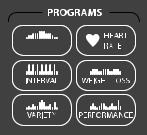
PROGRAMS Keypad
MANUAL
Diagram 15: PROGRAMS keypad
The PROGRAMS keypad provides access to all the exercise programs. Choosing a category and continually pressing the associated PROGRAMS key, cycles you through the menu selections. Refer to Table 3. For a description of each program, refer to Programs.
Note: Use the OK key to confirm your selection. For more information, refer to Workout Options.
Table 3. Available programs
PROGRAMS key |
Menu Selections |
9.31 |
9.33 |
MANUAL |
Manual |
|
|
INTERVAL |
Interval |
|
|
VARIETY |
Random |
|
|
|
1 Custom† |
|
|
|
2 Custom† |
|
|
HEART RATE |
Basic HR* |
|
|
|
Weight Loss HR* |
|
|
WEIGHT LOSS |
Weight Loss |
|
|
|
Weight Loss HR* |
|
|
PERFORMANCE |
5 K |
|
|
|
10 K |
|
|
|
Mile |
|
|
|
WALK 1 |
|
|
|
WALK 2 |
|
|
|
WALK 3 |
|
|
|
RUN 1 |
|
|
|
RUN 2 |
|
|
|
RUN 3 |
|
|
* Use of chest strap or the touch-sensitive grips is required.
† Appears when you select a USER key.
Owner’s Manual: Display Console |
24 |
